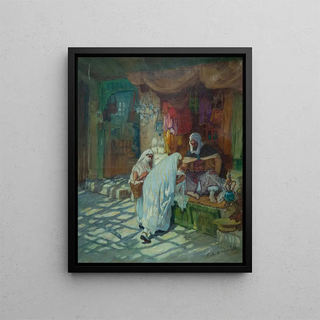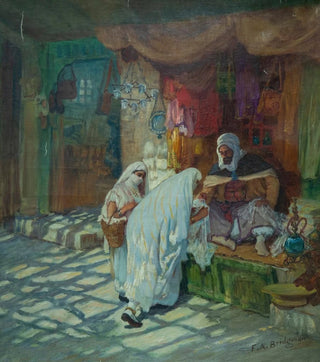Art print | The Bazaar - Frederick Arthur Bridgman


View from behind

Frame (optional)
In a world where art transcends eras and cultures, "Le Bazar" by Frederick Arthur Bridgman stands as an iconic artwork that invites a sensory immersion into the heart of oriental life. This canvas, vibrant with colors and light, transports the viewer to a lively souk, where the scents of spices and bursts of laughter mingle with the hustle of merchants. The artist manages to capture not only a scene but also an atmosphere, a cultural essence that still resonates today. The art print Le Bazar - Frederick Arthur Bridgman allows for rediscovering this fascinating scene, offering a window into a world that is both distant and familiar.
Style and uniqueness of the work
The strength of "Le Bazar" lies in Bridgman's technical mastery, combining striking realism with impressionist sensitivity. The meticulous details of fabrics, the light filtering through colorful veils, and the expressiveness of faces testify to attentive observation and a deep understanding of the subject. Each character, whether seller or buyer, is animated with a life of its own, as if caught in a frozen moment that could come to life at any instant. The warm, earthy colors, typical of oriental markets, create a visual harmony that captivates the eye and stimulates the imagination. The dynamic composition, between shadow and light, guides the viewer through this vibrant scene, where each element seems to tell a story.
The artist and his influence
Frederick Arthur Bridgman, an American artist of the 19th century, is recognized for his exploration of oriental themes, inspired by his travels in North Africa and the Middle East. His work is part of the orientalism movement, which seeks to capture the exoticism and beauty of non-Western cultures. Bridgman, through his refined technique and keen observation, distinguished himself from his contemporaries by offering a personal and intimate vision of these distant lands. His influence endures, inspiring many artists and art enthusiasts to explore the richness of oriental cultures. Through "Le Bazar," he does not merely reproduce a scene

Matte finish

View from behind

Frame (optional)
In a world where art transcends eras and cultures, "Le Bazar" by Frederick Arthur Bridgman stands as an iconic artwork that invites a sensory immersion into the heart of oriental life. This canvas, vibrant with colors and light, transports the viewer to a lively souk, where the scents of spices and bursts of laughter mingle with the hustle of merchants. The artist manages to capture not only a scene but also an atmosphere, a cultural essence that still resonates today. The art print Le Bazar - Frederick Arthur Bridgman allows for rediscovering this fascinating scene, offering a window into a world that is both distant and familiar.
Style and uniqueness of the work
The strength of "Le Bazar" lies in Bridgman's technical mastery, combining striking realism with impressionist sensitivity. The meticulous details of fabrics, the light filtering through colorful veils, and the expressiveness of faces testify to attentive observation and a deep understanding of the subject. Each character, whether seller or buyer, is animated with a life of its own, as if caught in a frozen moment that could come to life at any instant. The warm, earthy colors, typical of oriental markets, create a visual harmony that captivates the eye and stimulates the imagination. The dynamic composition, between shadow and light, guides the viewer through this vibrant scene, where each element seems to tell a story.
The artist and his influence
Frederick Arthur Bridgman, an American artist of the 19th century, is recognized for his exploration of oriental themes, inspired by his travels in North Africa and the Middle East. His work is part of the orientalism movement, which seeks to capture the exoticism and beauty of non-Western cultures. Bridgman, through his refined technique and keen observation, distinguished himself from his contemporaries by offering a personal and intimate vision of these distant lands. His influence endures, inspiring many artists and art enthusiasts to explore the richness of oriental cultures. Through "Le Bazar," he does not merely reproduce a scene






